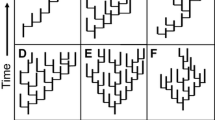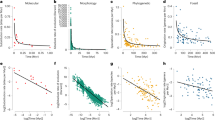Abstract
David Steen and co-authors in this journal offer a philosophical argument to support an “Evolutionary Community Concept” to identify what they call “evolutionary communities.” They describe these as “unique collections of species that interact and have co-evolved in a given geographic area” and that include “co-evolved dependencies between different parts of a community.” Steen et al. refer to the coevolution of assemblages, collections, communities, dependencies, interspecific and abiotic interactions, and traits, but they do not define “co-evolution” or provide an example in which co-evolution (as distinct from interaction) has been demonstrated. There may be as many ways to explain interactions among species as these interactions themselves; they may result, for example, from ecological fitting and phenotypic plasticity. In this paper, I argue that standard Darwinian Theory explains intraspecific microevolution or descent with modification within an interbreeding and potentially continuous population. The power, mechanism, or force that causes interspecific co-evolution, especially at the community scale, requires further explanation.
Similar content being viewed by others
References
Agosta SJ, Klemens JA (2008) Ecological fitting by phenotypically flexible genotypes: implications for species associations, community assembly and evolution. Ecol Lett 11(11):1123–1134
Allee WC, Park O, Emerson AE, Park T, Schmidt KP (1949) Principles of animal ecology (No. 591.5/A422). WB Saunders, Philadelphia
Araujo SB, Braga MP, Brooks DR, Agosta SJ, Hoberg EP, von Hartenthal FW, Boeger WA (2015) Understanding host-switching by ecological fitting. PLoS ONE 10(10):e0139225
Barrows CW, Murphy-Mariscal ML, Hernandez RR (2016) At a crossroads: the nature of natural history in the twenty-first century. Bioscience 66(7):592–599
Bonnicksen TM (2000) America’s Ancient forest: from the ice age to the age of discovery. Wiley, New York
Carmona D, Fitzpatrick CR, Johnson MT (2015) Fifty years of co-evolution and beyond: integrating co-evolution from molecules to species. Mol Ecol 24(21):5315–5329
Carroll WC, Kapeluck PR, Harper RA, Van Lear DH (2002) Background paper: historical overview of the southern forest landscape and associated resources. In: Wear DN, Greis JG (eds) Southern forest resource assessment. USDA Forest Service GTR SRS-53, Asheville, pp 583–606
Clewell AF (1989) Natural history of wiregrass (Aristida strida Michx., Gramineae). Nat Areas J 9:223–233
Collier J (2000) Autonomy and process closure as the basis for functionality. Ann N Y Acad Sci 901(1):280–290
Croker RA (2001) Stephen Forbes and the rise of American ecology. Smithsonian Institution Press, Washington
Curtin CG, Parker JP (2014) Foundations of resilience thinking. Conserv Biol 28(4):912–923
Dice L (1952) Natural communities. University of Michigan Press, Ann Arbor
Dobzhansky T (1973) Nothing in biology makes sense except in the light of evolution. Am Biol Teach 35:125–129
Donhauser J (2018) Informative ecological models without ecological forces. Synthese. https://doi.org/10.1007/s11229-018-1859-8
Dussault AC, Bouchard F (2017) A persistence enhancing propensity account of ecological function to explain ecosystem evolution. Synthese 194(4):1115–1145
Ehrlich PR, Raven PH (1964) Butterflies and plants: a study in coevolution. Evolution 18(4):586–608
Folke C, Carpenter S, Walker B, Scheffer M, Elmqvist T, Gunderson L, Holling CS (2004) Regime shifts, resilience, and biodiversity in ecosystem management. Annu Rev Ecol Evol Syst 35:557–581
Forbes SA (1880) On some interactions of organisms. Bull Ill State Lab Nat Hist I:3–17
Forbes SA (1925 [1887]) The lake as a microcosm. Ill Nat Hist Surv Bull 015(09)
Futuyma DJ (2013) The evolution of evolutionary ecology. Isr J Ecol Evolut 59(4):172–180
Ginzburg L, Colyvan M (2004) Ecological orbits: how planets move and populations grow. Oxford University Press on Demand, Oxford
Gleason HA (1926) The individualistic concept of the plant association. Bull Torrey Bot Club 53(1):7–26
Gleason HA (1927) Further views on the succession concept. Ecology 8:299–326
Gleason HA (1939) The individualistic concept of the plant association. Am Midl Nat 21(1):92–110
Gould SJ (1998) An evolutionary perspective on strengths, fallacies, and confusions in the concept of native plants. Arnoldia 58(1):3–10
Grant PR, Grant BR (1995) Predicting microevolutionary responses to directional selection on heritable variation. Evolution 49:241–251
Greene HW, Losos JB (1988) Systematics, natural history, and conservation: field biologists must fight a public-image problem. Bioscience 38:458–462
Grimm V (1998) To be, or to be essentially the same: the self-identity of ecological units’. Trends Ecol Evol 13(8):298–299
Gunderson LH, Allen CR, Holling CS (eds) (2012) Foundations of ecological resilience. Island Press, Washington
Haila Y, Taylor P (2001) The philosophical dullness of classical ecology, and a Levinsian alternative. Biol Philos 16(1):93–102
Hembry DH, Yoder JB, Goodman KR (2014) Coevolution and the diversification of life. Am Nat 184(4):425–438
Herrera CM (1988) Habitat-shaping, host plant use by a hemiparasitic shrub, and the importance of gut fellows. Oikos 51:383–386
Holling CS (1973) Resilience and stability of ecological systems. Annu Rev Ecol Syst 4(1):1–23
Holling CS (1996) Engineering resilience versus ecological resilience. In: Schulze PC (ed) Engineering within ecological constraints. National Academy Press, Washington, pp 31–44
Janz N (2011) Ehrlich and Raven revisited: mechanisms underlying codiversification of plants and enemies. Annu Rev Ecol Evol Syst 42:71–89
Janzen DH (1985) On ecological fitting. Oikos 45(3):308–310
Janzen DH, Hallwachs W (2016) Biodiversity conservation history and future in Costa Rica: the case of Área de Conservación Guanacaste (ACG), Ch. 10. In: Kappelle M (ed) Costa Rican ecosystems. University of Chicago Press, Chicago
Janzen DH, Martin PS (1982) Neotropical anachronisms: the fruits the gomphotheres ate. Science 215(4528):19–27
Jax K (2006) Ecological units: definitions and application. Q Rev Biol 81(3):237–258
Jax K, Jones CG, Pickett STA (1998) The self-identity of ecological units. Oikos 82:253–264
Jermy T (1984) Evolution of insect/host plant relationships. Am Nat 124(5):609–630
Johnson MTJ, Stinchcombe JR (2007) An emerging synthesis between community ecology and evolutionary biology. Trends Ecol Evol 22:250–257
Kettlewell HBD (1973) The evolution of melanism. Clarendon Press, Oxford
Kingsland SE (1994) Essay review: the history of ecology. J Hist Biol 27(2):349–357
Kitcher P (2000) Patterns of scientific controversies. In: Machamer P (ed) Scientific controversies: philosophical and historical perspectives. Oxford University Press, Oxford, pp 21–39
Levin SA (1981) The role of theoretical ecology in the description and understanding of populations in heterogeneous environments. Am Zool 21:865–875
Levins R, Lewontin R (1985) The dialectical biologist. Harvard University Press, Cambridge
Lovejoy AO (1959) The great chain of being. Harper and Row, New York
Maynard-Smith J (1964) Group selection and kin selection. Nature 201(4924):1145–1147
Mayr E (1942) Systematics and the origin of species. Columbia University Press, New York
McIntosh RP (1980) The background and some current problems of theoretical ecology. Synthese 43(2):195–255
McPeek MA (2017a) Evolutionary community ecology, vol 58. Princeton University Press, Princeton
McPeek MA (2017b) The ecological dynamics of natural selection: traits and the coevolution of community structure. Am Nat 189(5):E91–E117
Means BD (2006) Vertebrate faunal diversity of longleaf pine ecosystems. In: Jose S, Jokela E, Miller DL (eds) The longleaf pine ecosystem: ecology, silviculture, and restoration. Springer, New York, pp 157–213
Noss RF (1996) The naturalists are dying off. Conserv Biol 10:1–3
Nylin S, Agosta S, Bensch S, Boeger WA, Braga MP, Brooks DR, Schäpers A (2018) Embracing colonizations: a new paradigm for species association dynamics. Trends Ecol Evolut 33(1):4–14
Odum EP (1992) Great ideas in ecology for the 1990’s. Bioscience 42:542–545
Paley W (1810 [1802]) The works of William Paley, DD: Natural theology, vol 1. Joshua Belcher
Patten BC (1975) Ecosystem as a co-evolutionary unit: a theme for teaching systems ecology. In: Innis GS (ed) New directions in the analysis of ecological systems. Part 1. Society for Computer Simulation, La Jolla, pp 1–8
Phillips D (2003) The truth of ecology: nature, culture, and literature in America. Oxford University Press, Oxford
Pimm SL (1991) The balance of nature? Ecological issues in the conservation of species and communities. University of Chicago Press, Chicago
Pyle RM (2001) The rise and fall of natural history: how a science grew that eclipsed direct experience. Orion 20:16–23
Pyne SJ, Andrews PL, Laven RD (1996) Introduction to wildland fire, 2nd edn. Wiley, NY
Quine W (1969) Ontological relativity and other essays. Columbia University Press, New York
Rodriguez RA, Herrera AM, Santander J, Miranda JV, Perdomo ME, Quirós Á, Riera R, Fath BD (2016) From a stationary to a non-stationary ecological state equation: adding a tool for ecological monitoring. Ecol Model 320:44–51
Salt GW (1983) Roles: their limits and responsibilities in ecological and evolutionary research. Am Nat 122(5):697–705
Sherbakov DY, Kovalenkova MV, Maikova OO (2016) Recent results of molecular-phylogenetic studies of endemic invertebrates inhabiting Lake Baikal. Vavilovskii Zhurnal Genetiki i Selektsii Vavilov J Genet Breed 20(4):403–407
Silver B (1978) William Bartram’s and other eighteenth-century accounts of nature. J Hist Ideas 39(4):597–614
Simberloff D (1980) A succession of paradigms in ecology: essentialism to materialism and probabilism. Synthese 43(1):3–39
Simberloff D (1983) Competition theory, hypothesis-testing, and other community ecological buzzwords. Am Nat 122(5):626–635
Simberloff D (2004) Community ecology: is it time to move on? (An American Society of Naturalists Presidential Address). Am Nat 163(6):787–799
Simberloff D (2010) Invasions of plant communities—more of the same, something very different, or both? Am Midl Nat 163(1):220–233
Snaydon RW (1970) Rapid population differentiation in a mosaic populations to soils. Evolution 24:257–269
Sober E (1984) The nature of selection: evolutionary theory in philosophical focus. MIT Press, Cambridge
Soulé ME (1985) What is conservation biology? Bioscience 35(11):727–734
Stearns SC (1983) The genetic basis of differences in life-history traits among six populations of mosquitofish (Gambusia affinis) that shared ancestors in 1905. Evolution 37:618–627
Steen DA, Barrett K, Clarke E, Guyer C (2017) Conceptualizing communities as natural entities: a philosophical argument with basic and applied implications. Biol Philos 32:1019–1034
Sterelny K (1995) Understanding life: recent work in philosophy of biology. Br J Philos Sci 46(2):155–183
Suchan T, Alvarez N (2015) Fifty years after Ehrlich and Raven, is there support for plant–insect coevolution as a major driver of species diversification? Entomol Exp Appl 157(1):98–112
Tewksbury JJ et al (2014) Natural history’s place in science and society. Bioscience 64:300–310
Turcotte MM, Levine JM (2016) Phenotypic plasticity and species coexistence. Trends Ecol Evol 31(10):803–813
Van Lear DH, Carroll WD, Kapeluck PR, Johnson R (2005) History and restoration of the longleaf pine-grassland ecosystem: implications for species at risk. For Ecol Manag 211(1–2):150–165
Webb SD (1974) Chronology of Florida Pleistocene mammals. In: Webb SD (ed) Pleistocene mammals of Florida. University Press of Florida, Gainesville, pp 5–31
Webb SD (1977) A history of savanna vertebrates in the New World. Part I: North America. Annu Rev Ecol Syst 8:355–380
Webb CO, Ackerly DD, McPeek MA, Donoghue MJ (2002) Phylogenies and community ecology. Annu Rev Ecol Syst 33(1):475–505
White TCR (2013) Experimental and observational evidence reveals that predators in natural environments do not regulate their prey: they are passengers, not drivers. Acta Oecol 53:73–87
Whittaker RH (1975) Communities and ecosystems, 2nd edn. Macmillan, Collier, New York
Wilcove DS, Eisner TS (2000) The impending extinction of natural history. Chron High Educ 47(3):B24
Wilkinson DM (2004) The parable of Green Mountain: ascension Island, ecosystem construction and ecological fitting. J Biogeogr 31:1–4
Williams GC (1966) Adaptation and natural selection: a critique of some current evolutionary thought. Princeton University Press, Princeton
Wilson DS, Sober E (1989) Reviving the superorganism. J Theor Biol 136(3):337–356
Zamora R (2000) Functional equivalence in plant-animal interactions: ecological and evolutionary consequences. Oikos 88(2):442–447
Author information
Authors and Affiliations
Corresponding author
Additional information
Publisher's Note
Springer Nature remains neutral with regard to jurisdictional claims in published maps and institutional affiliations.
Rights and permissions
About this article
Cite this article
Sagoff, M. When is it co-evolution? A reply to Steen and co-authors. Biol Philos 34, 10 (2019). https://doi.org/10.1007/s10539-018-9656-9
Received:
Accepted:
Published:
DOI: https://doi.org/10.1007/s10539-018-9656-9




